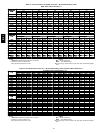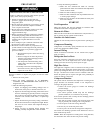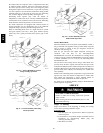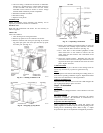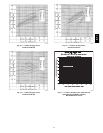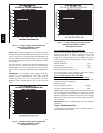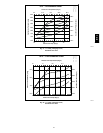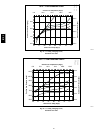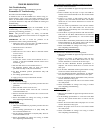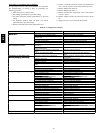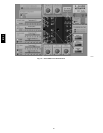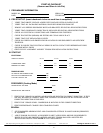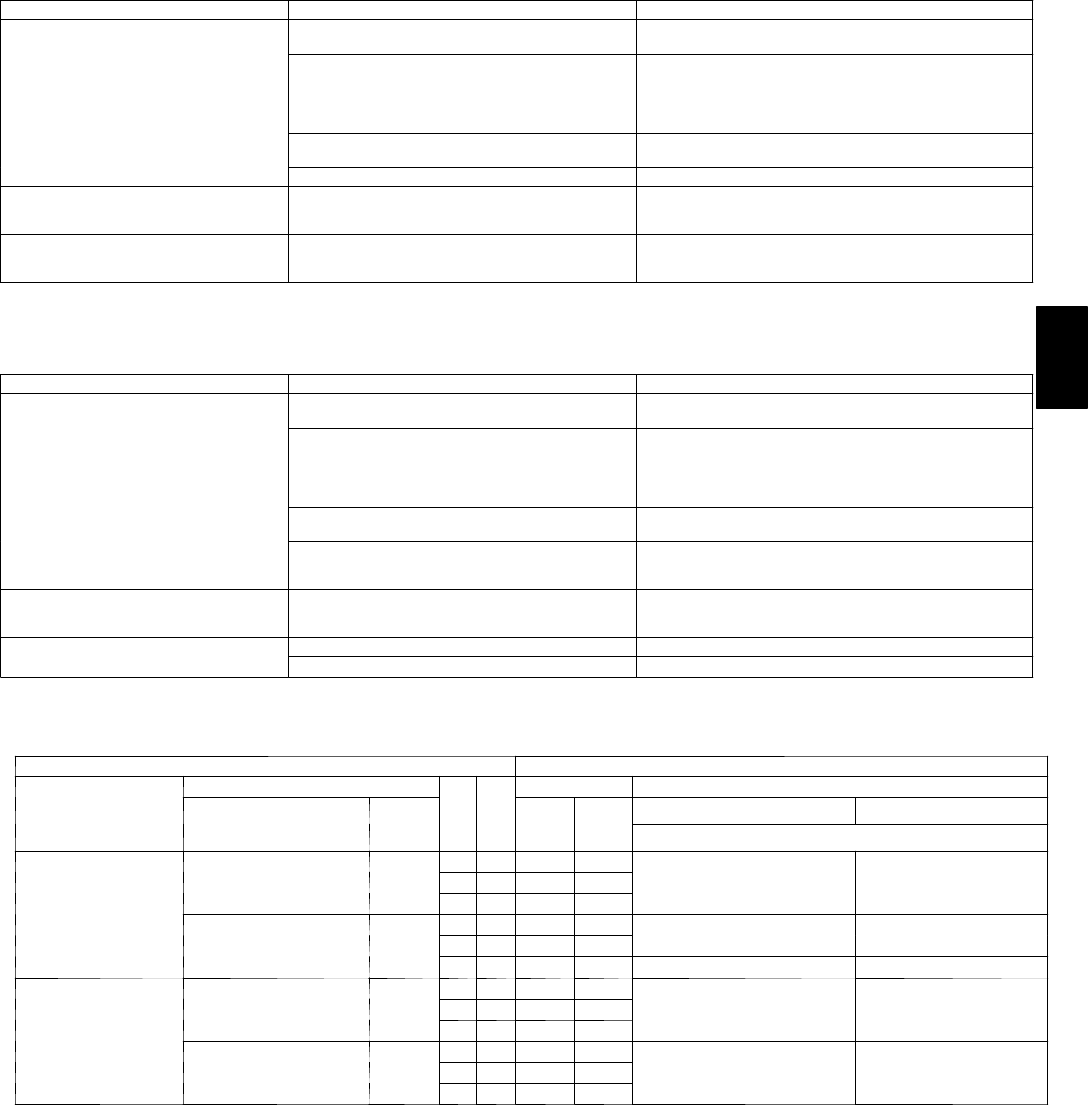
59
Table 36—Perfect Humidi ty Adaptive Dehumidification System Subcooling Mode Service Analysis
PROBLEM CAUSE REMEDY
Subcooling Mode (Liquid Reheat)
Will Not Energize.
No power to control transformer from
evaporator-fan motor.
Check power source and evaporator-fan relay. Ensure all
wire connections are tight.
W
i
l
l
N
o
t
E
n
e
r
g
i
z
e
.
No power from control transformer to liquid line
solenoid valve.
1. Fuse open; check fuse. Ensure continuity of wiring.
2. Low-pressure switch open. Cycle unit off and allow
low-pressure switch to reset. Replace s witch if i t will
not close.
3. Transformer bad; check transformer.
Liquid line solenoid valve will not operate. 1. Solen oid coil defective; replace.
2. Solenoid valve stuck open; replace.
Liquid line solenoid valve will not open. Valve is stuck closed; replace valve.
Low System Capacity . Low refrigerant charge orfrosted evaporator coil. 1. Check charge amount. Charge per Fig. 53---56.
2. Evaporator coil frosted; check and replace low-pres-
sure switch if necessary .
Loss of Compressor Superheat
Conditions with Subcooling/Reheat
Dehumi dification Coil Ener gized.
Thermostatic expansion valve (TXV). 1. Check TXV bulb mounting, and secure tightly to suc-
tion line.
2. Replac e TXV if stuck open or close d.
Table 37—Perfect Humidi ty Adaptive Dehumidification System Hot Gas Reheat Mode Service Analysis
PROBLEM CAUSE REMEDY
Reheat Mode Will Not Energize. No power to control transformer from
evaporator-fan motor.
Check power source and evaporator-fan relay. Ensure all
wire connections are tight.
No power from control transformer to hot gas
line solenoid valve
1. Fuse open; check fuse. Ensure continuity of wiring.
2. Low-pressure switch open. Cycle unit off and allow
low-pressure switch to reset. Replace s witch if i t will
not close.
3. Transformer bad; check transformer.
Hot gas line solenoid valve will not operate. 1. Solenoid coil defective; replace.
2. Solenoid valve stuck closed; replace.
Low refrigeran t charge or frosted evaporator coil. 1. Check charge amount. Charge per Fig. 53---56.
2. Evaporator coil frosted; check and replace low-pres-
sure switch if necessary .
Loss of Compressor Superheat
Conditions with Subcooling/Reheat
Dehumi dification Coil Ener gized.
Thermostatic expansion valve (TXV). 1. Check TXV bulb mounting, and secure tightly to suc-
tion line.
2. Replac e TXV if stuck open or close d.
Excessive Superheat. Liquid line solenoid valve will not operate. Valve is stu ck, replace valve.
E
x
c
e
s
s
i
v
e
S
u
p
e
r
h
e
a
t
.
Hot gas line solenoid valve will not close. Valve is stuck; replace valve.
Table 38—EconoMi$er IV Input/Output Logic
INPUTS OUTPUTS
D
e
m
a
n
d
C
o
n
t
r
o
l
Enthalpy* Compressor NTerminal†
D
eman
d
C
ontro
l
V
t
i
l
t
i
(
D
C
V
)
O
u
t
d
o
o
r
R
e
t
u
r
n
Y1 Y2
Stage Stage
Occupied Unoccupied
V
entilatio n (DC
V
)
O
ut
d
oor
R
eturn
Y
1
Y
2
1 2
Damper
Below set
(
D
C
V
L
E
D
O
f
f
)
High
(
F
C
l
i
L
E
D
O
f
f
)
Low
On On On On
Minimum position Closed
B
e
l
o
w
s
e
t
(DCV LED Off)
H
i
g
h
(F ree Cooling LED Off)
L
o
w
On Off On Off
M
i
n
i
m
u
m
p
o
s
i
t
i
o
n
C
l
o
s
e
d
Off Off Off Off
Low
(
F
C
l
i
L
E
D
O
)
High
On On On Off
Modulating** (between min.
i
i
d
f
l
l
)
Modulating** (between
l
d
d
f
l
l
)
L
o
w
(F ree Cooling LED On)
H
i
g
h
On Off Off Off
M
o
d
u
l
a
t
i
n
g
(
b
e
t
w
e
e
n
m
i
n
.
position and full-open)
M
o
d
u
l
a
t
i
n
g
(
b
e
t
w
e
e
n
closed and full-open)
Off Off Off Off Mini mum position Closed
Above set
(
D
C
V
L
E
D
O
)
High
(
F
C
l
i
L
E
D
O
f
f
)
Low
On On On On
Modulating†† (between min.
i
i
d
D
C
V
i
)
Modulating†† (between
l
d
d
D
C
V
A
b
o
v
e
s
e
t
(DCV LED On)
H
i
g
h
(F ree Cooling LED Off)
L
o
w
On Off On Off
M
o
d
u
l
a
t
i
n
g
†
†
(
b
e
t
w
e
e
n
m
i
n
.
position and DCV maximum)
M
o
d
u
l
a
t
i
n
g
†
†
(
b
e
t
w
e
e
n
closed and DCV
m
a
x
i
m
u
m
)
Off Off Off Off
ma
x
imum)
Low
(
F
C
l
i
L
E
D
O
)
High
On On On Off
Modulating*** Modulating†††
L
o
w
(F ree Cooling LED On)
H
i
g
h
On Off Off Off
M
o
d
u
l
a
t
i
n
g
M
o
d
u
l
a
t
i
n
g
†
†
†
Off Off Off Off
*For single enthalpy co ntrol, the module compares outdoor entha lpy to the ABCD set point.
†Power at N t erminal determi nes Occupied/Unoccupied setting: 24 vac (Occupied), no power (Unoccupied).
**Modulation is based on the supply-air sensor signal.
††Modulation is based on the DCV signal.
***Modulation is based on the greater of DCV and supply-air sensor signals, between minimum position and either maximum position (DCV) or fully open (sup-
ply-air si gnal).
†††Modulation is based on the greater of DCV and supply-air sensor signals, between closed and either maximum position (DCV) or fully open (supply-airsig-
nal).
551B,C



